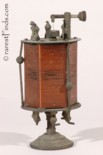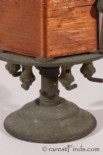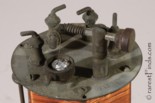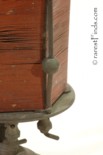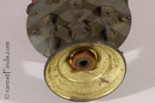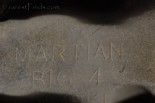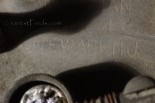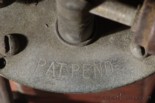Earliest Martian Big 4 Crystal Radio with unique round Base. Sold!
Patents, click on any image to see larger image!
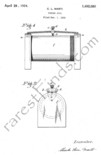
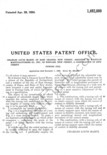
Martian Big 4 Crystal sets are rare; however all of the few known examples have a tripod base. The set offered here has a round base; it is the only known set with a round base manufactured in the USA. The set is marked “MARTIAN BIG 4 NEWARK NJ”. The set was named by its inventor, Charles Louis Marti, who had a number of patents to his name. The relevant patent to this crystal set is the patent with the number 1,492,080 (see above images.) The set has binding posts to connect four headphones; hence, “BIG 4.“
Radio collector Erich E. Brueschke wrote a comprehensive report about his study of the Martian Big 4 crystal radios which was published in The Antique Wireless Association Review, Volume 25, p.p. 125-146, 2012. Brueschke is the owner of the largest collection of crystal sets based on Marti’s patent. In the introductory of his report [1] page 126, Brueschke writes, “As we will show, they have central elements in common. These are: They all have three legs made of nickel plated brass or pot metal. [...] ” Another constant of all Martian sets are the two balls sliding vertically on springs to tune the coil; the feature patented by Marti, who was the president of the Martian Manufacturing Company in Newark, New Jersey.
In his well researched article [1], Bruescheke distinguishes between seven different versions of crystal sets based on Marti’s patent, made by different manufacturers; the version of the Martian Big 4 here offered is not mentioned and the writer assumes he did/does not know about it.
The set offered here has only the town of manufacturer and no manufacturer’s name imprinted. Therefore, the set could have been manufactured by Martian Manufacturing Company, 171 Washington Street; Metro Electric Co., 67 Globe street; Metropolitan Radio Corporation, 71-75 Goble Street; United Specialties Co., Inc., 57-59 Spring Street; White Manufacturing Company, 93-107 Lafayette Street; or another (unknown) manufacturer also located in Newark, New Jersey.
The writer is sure that the round base of the set offered here is original to the set, as it has the same patina as the rest of the set.
There is also an exceedingly rare version of this crystall radio manufactured by Haelbig & Co., Dieffenbachstrasse 37, Berlin S 59, Germany. Haelbig’s version of the crystal set based on Marti’s patent has the identical round base. To see that example, click here!
Haelbig called its crystal set Saturn for an obvious reason. The writer found a listing of companies and their business activities, dated 1920. In that listing, the company was actually called Saturnfabrik (Saturnfactury) Haelbig & Co., and its business as, “Manufacturing and Distribution of radioactive metal-ware. Merchandise: Luminous letters and characters to make them visible in darkness,” see picture on the left.
Is it possible that Marti thought of Martian, also an extra terrestrial name, becaus of the name of its German counterpart Saturn? The writer would find this assumption likely. If Marti first sought to have his crystal radio manufactured in Germany, the name Saturn was the obvious choice. Unsuccessful with the German manufacturer, Marti could have started manufacturing his crystal radio in the USA where he resided. Consequently he thought of the name Martian after Saturn. Is this to far fetched?
Without further research, the writer is of the opinion that it is possible that the sequence of Brueschke’s time line for the different versions [1] may need to be updated after the discovery of yet another version.
Considering the fact that Marti was a citizen of Switzerland according to his patent papers, he could have tried to have his radio manufactured by Haelbig & Co., in the neighboring country of Germany and in the United States later, or at the same time. Haelbig produced very few of its version of the crystal set based on Marti’s patent with the round base, and so did the manufacturer located in Newark, NJ. After changing the design, Martian Manufacturing Company, 171 Washington Street, Newark, New Jersey, was successful in manufacturing and marketing sets with the familiar tripod base. A tripod certainly gives the set more stability - necessary if four headsets are connected, pulling the set in different directions. This would explain the short lived production of the Martian with the round base.
According to Brueschke’s time line [1], the Martian Big 4 with pot metal was introduced late to keep cost low. This version had the captive lever binding posts as are present at the set offered here. In Brueschkes timeline, knurled binding posts were first and then later replaced by captive lever binding posts.
The writer thinks it was the other way around. On page 131 [1], Brueschke notes the problem with the internal connection between the detector on the top plate and the aerial binding post on the bottom plate. The 12 gauge cooper wire notoriously broke when to much torque-force was applied to the aerial binding post causing the binding post to turn.
Re-soldering the connection proved to be very difficult as the set needed to be disassembled. Knurled binding posts do not create the torque as lever binding posts when fastened with fingers of the human hand. It is reasonable to assume that this is why lever binding posts were first replaced by knurled binding posts at the bottom plate of the set, but eventually on the entire set.
Logic therefore suggests that the pot metal legs were first - after the round base - and not last, as they proved to be not strong enough and were replaced with three legged nickel plated brass stands or tripods to prevent breakage. Pot metal legs would not have survived a fall from a table to a hard floor. And the binding posts changed from captive lever binding posts to knurled posts for the reasons outlined above. Another scenario could be that the change from the tripods to the round base was another change to cut cost. The writer thinks the second scenario is the less likely one. However, the Saturn crystal set has knurled binding posts and does not fit the writer’s suggested timeline. The set offered here also bears the engraved writing, “PAT.PEND.”, indicating that the radio was manufactured before the patent was issues on April 29, 1924. However, the writer leaves it up to Bruescheke to sort it out, as he is undoubtedly the expert on the subject.
By December of 1923, White Manufacturing Company published an advertisement in Radio News, Volume 5, No. 6, page 835, a “Martian Big 4” with captive lever type binding posts and tripod stand (not known whether it was a pot metal or nickel plated version of the tripod). Price published was $7.50 (see picture on the right) [3].
Condition:
As the pictures show, this crystal set is not in the best of condition. Fortunately, every part with the exception of the large nut used to attach the round base to the radio is made of nickel plated brass. The nut is made of iron and somewhat rusty as shown in one of the pictures. The Gelena crystal was missing and has been replaced with a NOS Gelena crystal. The set is now complete and in ‘as found condition.’
History:
Crystal radio sets need no batteries or power source and run on the power received from radio waves by a long wire antenna. The antenna converts the energy in the electromagnetic radio waves striking it to an alternating electric current received with the antenna. The antenna is connected to the tuning coil. As all the power to operate a crystal radio comes from the antenna, it is important that the antenna collect as much power from the radio waves as possible. The longer an antenna, the more power it can intercept. In addition, antennas are most efficient when their length is close to a multiple of a quarter-wavelength of the radio waves they are receiving. Since the length of the waves used with crystal radios is very long the wire used as antenna needs to be as long as possible. AM broadcast radio waves are 182-566 meter (597-1857 feet) long. A popular practice was to use existing large metal objects, such as bedsprings, fire escapes, and barbed wire fences as antennas. In contrast the whip antennas or ferrite loopstick antennas used in modern radios are very short.
To adjust the wavelength of the signal source to the tuning coil, the two sliding balls were moved up and down. To rectify the radio frequency to obtain the audio frequency; this is the idea of Marti’s patent. A ‘cat’s whisker’ was moved across a crystal, in this case a bit of galena. When the whisker touches the galena it forms a crude and unstable point-contact metal-semiconductor junction, a Schottky barrier diode. The crystal requires just the right gentle pressure by the wire; too much pressure caused the device to conduct in both directions. Crystal radios are fun to use and work well close to AM radio stations and are utilized as experiments to this day.
Literature:
- The Antique Wireless Association Review, Erich E. Brueschke, Volume 25, p.p. 125-146, 2012.
- Crystal Clear, Vintage American Crystal Sets, Crystal Detectors, and Crystals, by Maurice L Sievers, Vestal Press 1991.
- Radio News, H. Gurnsback, Volume 5, No. 6, December 1923
Inventory Number 09342;
Price: Sold!
.
